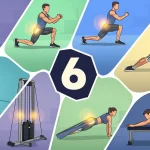Hello, Fit People! Have you ever heard the term physical fitness? It’s not just about appearance or having strong muscles, but about your body’s ability to function optimally during daily activities. In this article, we will dive deep into what physical fitness is, its components, its benefits, and effective tips to help you improve your physical fitness. Let’s get started!
What is Physical Fitness?
In simple terms, physical fitness refers to the body’s ability to perform physical activities efficiently. This includes various aspects such as muscle strength, cardiovascular endurance, and body flexibility. Having good physical fitness means that you’re not only able to engage in high-intensity workouts but can also handle daily activities without getting easily fatigued.
Physical fitness is typically divided into two main categories: health-related fitness and performance-related fitness. Health-related fitness is associated with physical well-being, which helps prevent chronic diseases such as diabetes and heart disease. On the other hand, performance-related fitness focuses on one’s ability to perform specific physical activities optimally, especially in sports.
Components of Physical Fitness
- Muscular Strength Muscular strength is the ability of muscles to exert maximum force in a single effort. It is crucial for heavy tasks like lifting, pushing, or pulling objects.
- Muscular Endurance Muscular endurance refers to the ability of muscles to continue working without fatigue over time. This is important for long-duration physical activities like running or long-distance cycling.
- Cardiovascular Endurance Cardiovascular endurance is the ability of the heart and lungs to efficiently distribute oxygen throughout the body during physical activities. Improving cardiovascular endurance helps your body work longer without tiring.
- Flexibility Flexibility is the ability of joints and muscles to move through a full range of motion. Good flexibility helps prevent injuries and enhances performance in daily activities as well as sports.
- Body Composition Body composition refers to the ratio of body fat to muscle mass, bones, and body fluids. A balanced body composition is essential for overall health.
- Balance and Coordination Balance is the ability to maintain your body’s center of gravity during both static and dynamic activities. Coordination is the ability to control your body’s movements accurately and efficiently.
Benefits of Physical Fitness
Improving physical fitness not only benefits your body but also has a wide range of positive impacts on your overall quality of life. Here are the key benefits of maintaining physical fitness:
- Improves Heart Health By enhancing cardiovascular endurance, you can reduce the risk of heart disease and high blood pressure. Aerobic exercises like running or cycling help keep your heart and lungs healthy.
- Helps Control Weight Regular physical activity, especially when combined with a balanced diet, helps control weight and reduce body fat. This is essential to prevent obesity and related health issues.
- Boosts Mental Health Exercise has been proven to reduce stress, anxiety, and symptoms of depression. Physical activity stimulates the production of endorphins, the hormones that make you feel happier and more relaxed. It also improves self-confidence and enhances sleep quality.
- Increases Strength and Stamina Physical fitness makes your body stronger and more resistant to fatigue. With stronger muscles and improved stamina, you can perform daily tasks and engage in sports more easily.
- Reduces Risk of Chronic Diseases Maintaining physical fitness can help lower the risk of chronic diseases such as type 2 diabetes, high cholesterol, and some types of cancer. Regular physical activity also helps maintain stable blood sugar levels.
- Enhances Mobility and Flexibility Exercises that involve stretching and flexibility, such as yoga or Pilates, help keep your joints and muscles flexible. This is important to prevent injuries and maintain agility, especially as you age.
- Improves Posture and Reduces Pain Regular strength training can improve your posture, which in turn reduces back or neck pain caused by poor sitting or standing positions.
Tips to Improve Physical Fitness
- Start with a Regular Exercise Routine You don’t need to jump straight into intense workouts. Start with simple routines like walking, light jogging, or joining aerobic classes at the gym. Consistency is key to seeing progress.
- Incorporate Strength Training To improve muscular strength, begin with light weightlifting exercises such as using dumbbells or doing bodyweight exercises like push-ups and squats. Strength training can boost your metabolism and improve your posture.
- Maintain a Balanced Diet Improving physical fitness isn’t just about exercising; it also involves watching what you eat. Make sure you consume a balanced diet with adequate protein, complex carbohydrates, healthy fats, vitamins, and minerals.
- Pay Attention to Rest and Recovery After exercising, your body needs time to recover. Don’t forget to allow your body adequate rest each day and ensure you get quality sleep to be ready for the next activities.
- Set Realistic Goals Set achievable fitness goals that you can gradually work towards. For example, increase your running duration or gradually lift heavier weights. By setting realistic goals, you’ll stay motivated to keep improving.
Conclusion
Physical fitness is a vital foundation for living a healthy and active life. By paying attention to the components of fitness such as muscular strength, endurance, flexibility, and body composition, you can live your days with more energy and productivity. Not only that, maintaining physical fitness offers many long-term health benefits, from heart health to mental well-being and improved posture.
So, Fit People, are you ready to improve your physical fitness? Let’s start with small steps and feel the positive changes in your life!





